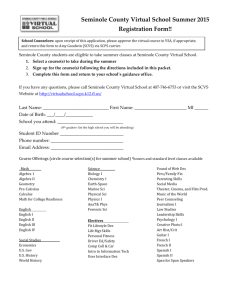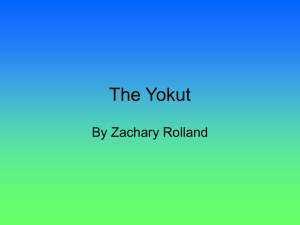Native American Tribes Notes (ppt)
advertisement
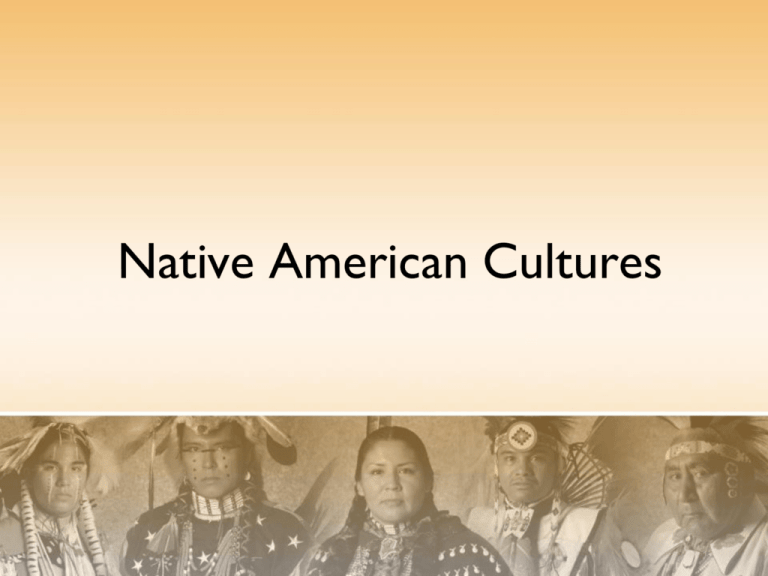
Native American Cultures Why do we call them Native Americans instead of Indians? • Native American and American Natives are synonyms. • We use the term Native Americans instead of Indians. • When explorers from Europe came to North America for the first time, they thought they were in India, so they called the people there Indians. • Because they were in fact in the U.S., and not in India we do not use the term Indians. Inuit Tribe Location • The Inuit Tribe lived in the Arctic, what is now Alaska and the northernmost Canada. • What color represents the region in which the Intuits lived? Way of Life • In the winter, Inuits lived in igloos, or homes made of ice. (Buurrr!) Way of Life • In the warmer months, the Inuits lived in tents made from animal skin. Way of Life “Foxes, caribou, and polar bears. Oh my!” • Because it was extremely cold in the Arctic, few plants could grow in this region. • The Inuit hunted foxes, caribou, and polar bears. • Harpoons and kayaks were used to hunt seals, walruses, and whales. • A kayak is a one person canoe made of animal skins stretched over wood or bone. Way of Life • Resources were limited..they couldn’t go to Target or Wal-mart for things! • Seals were caught for their skins, to make clothes and tents. • Oil was used for light and heat • Bones were used to make tools Family • Family was an important part of Inuit society. • They lived in groups of 60 to 300 people, made up of several families. • The families made decisions, hunted, and traveled together. • Life was extremely difficult in the Arctic due to the climate. Resources were limited, therefore, they had to work together and share what they had in effort to survive. Q&A • • • • • • • In what region did the Inuit live? What country and state can this region be found? What kind of homes did the Inuit build? What were their natural resources? What is a kayak? How did the climate of the Arctic affect the Inuit? Why do you think they had to share their food to survive? Kwakiutl Tribe Location • The Kwakiutl lived in the Northwest region. What color represents where they lived? Shelter • The Kwakiutl lived in coastal villages of rectangular cedar-plank houses with bark roofs. Usually these houses were large (up to 100 feet long) and each one housed several familes from the same clan (as many as 50 people.) • The photo below shows the frame of a Kwakiutl home. Location • The tribe lived very close to the ocean. • Cool winds brought heavy rains, so the forests grew thick and tall. • The region was full of forests and rivers, which had plenty of fish and other animals. Way of Life • Instead of farming, the Kwakiutl, met their needs by fishing, hunting, and gathering plants and nuts. • Salmon, a type of fish, was a common food eaten. • Whales provided food and fat. The fat was melted into oil to burn in lamps. • Unlike neighboring tribes, the Kwakiutl did not hunt whales, they only captured the whales that were beached, or stranded on shore. Q&A • • • • In what region did the Kwakiutl live? What was the climate like? How did the resources compare to that of the Inuit? Did this tribe hunt Whales? What did they use whales for? Nez Perce Location • The Nez Perce lived to the northwest on the Columbian Plateau. This included parts of Idaho, Oregon, and Washington, also known as Oregon Country. Climate and Resources • The Nez Perce lived in an area with dry hills and flatlands. • Like the Kwakiutl, they caught a lot of salmon from the rivers and streams that drained the high plateau. • Long spears and nets were used to catch the fish. Q&A • • • • Where did the Nez Perce reside or live? What is a plateau? What what was their major resource for food? What did they use to catch their food? Hopi Location • The Hopi lived in the Southwest in what today is Arizona. What do you think the climate is like? Shelter • The Hopi were also known as Pueblo people because their homes were called Pueblos. • Pueblos were made from dirt, rocks, and straw. Some had as many as five levels. Climate • The desert Southwest, with its mesas, canyons, cliffs and mountains, was a hard place to live. • The summer were extremely hot and the winters were very cold. • Weeks can go by without a drop of rain or snow. Way of Life • The Hopi had to adapt, or adjust to the land and climate in order to survive. • They grew crops such as corn, beans, and squash. • They also grew cotton to make clothes or weave blankets. Q&A • • • • Where did the Hopi live? In what state and region? What was the climate like? What is a pueblo and how is one made? What kind of crops were the Hopi able to grow? Pawnee Location • The Pawnee Indians are original people of Nebraska and Kansas. • The Pawnee tribe was forced to move to a reservation in Oklahoma during the 1800's, and most Pawnee people are still living in Oklahoma today. Pawnee Children • Many Pawnee children like to go hunting and fishing with their fathers. • In the past, Pawnee kids had more chores and less time to play in their daily lives. • They did have dolls, toys, and games to play. • A Pawnee mother traditionally carried a young child in a cradleboard on her back Way of Life • Pawnee men were hunters and sometimes went to war to protect their families. • Pawnee women were farmers and also did most of the child care and cooking. Women farmed corn, pumpkin, beans, squash, and cooked the buffalo • The Pawnees built their villages near rivers so they could get water and wood for fire. Way of Life- shelter • Most Pawnee Indians lived in settled villages of round earthen lodges. • Pawnee lodges were made from wooden frames covered with packed soil. • When the Pawnee tribe went on hunting trips, they used buffalo-hide tipis (or teepees) as temporary shelter. Way of Life- clothing • Pawnee women wore deerskin skirts and poncho-like blouses. • Pawnee men wore breechcloths and leather leggings. Men did not usually wear shirts, but warriors sometimes wore special buckskin war shirts. • The Pawnees wore moccasins on their feet, and in cold weather, they wore long buffalo-hide robes. Q&A • The Pawnee Native Americans are natives of what two states? • What state do the Pawnee’s live in today? • What is the baby carrier called that the Pawnee mothers carried on their back? • What were the jobs of the men and women? • Where did they build their villages? • Their houses were called _____________? • Women wore what and men wore what? What did they wear on their feet? Seminole Where they live • The Seminoles lived in Florida. • They started out in northern Florida, but when the Americans attacked them, the Seminole tribe retreated further south, into the Everglades. • Some Seminole people were forced to move to Oklahoma in the 1800's. • Other Seminole people still live in southern Florida today. Way of Life • Seminole men were hunters and sometimes went to war to protect their families. • Seminole women were farmers and also did most of the child care and cooking. • Both genders took part in storytelling, artwork and music, and traditional medicine. • In the past, the chief was always a man, but today a Seminole woman can participate in government too. Shelter • The Seminole people lived in houses called chickees. • Seminole chickees were made of wood and plaster, and the roofs were thatched with palmetto fiber. • They also began building their houses on wooden stilts that raised the floor two or three feet off the ground. This protected their homes from flooding and swamp animals. Clothing • Seminole men wore breechcloths. Seminole women wore wraparound skirts, usually woven from palmetto. Shirts were not necessary in Seminole culture. • The Seminoles also wore moccasins on their feet • Seminole men usually shaved their heads except for a single strip of hair- this became known as the mohawk • The Seminoles wore elaborate tribal tattoos, but rarely painted their faces Transportation • the Seminole Indians made flat dugout canoes from hollowed-out cypress logs. • They steered these boats with poles rather than paddles, and sometimes used sails made from palmetto fiber. • Over land, the Seminoles used • dogs as pack animals. Food • The Seminoles were farming people. • Seminole women harvested crops of corn, beans, and squash. • Seminole men did most of the hunting and fishing, catching game such as deer, wild turkeys, rabbits, turtles, and alligators. Weapons • Seminole hunters used bows and arrows. • Fishermen usually used fishing spears. • Seminole warriors fired their bows or fought with tomahawks. Q&A • • • • What state did the Seminoles live in? What were the jobs of the men and women? Was the chief usually a man or woman? What were the Seminole houses called and what were they made out of? • Instead of painting their faces, what did the Seminole men do? • What did they travel in the water in? • They used __________ and __________ when hunting.
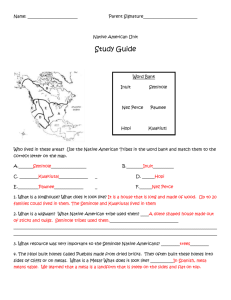

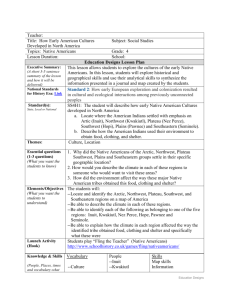
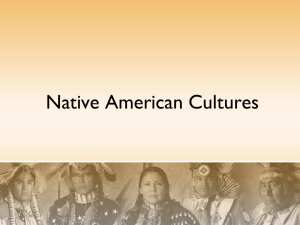
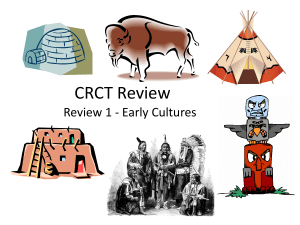

![Native American Nations - recent[1]](http://s2.studylib.net/store/data/005323714_1-a69fd33325ce9da35d9c0bbfecf195a7-300x300.png)
